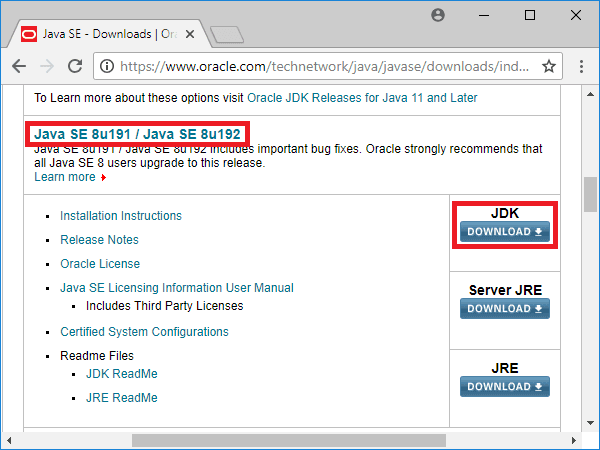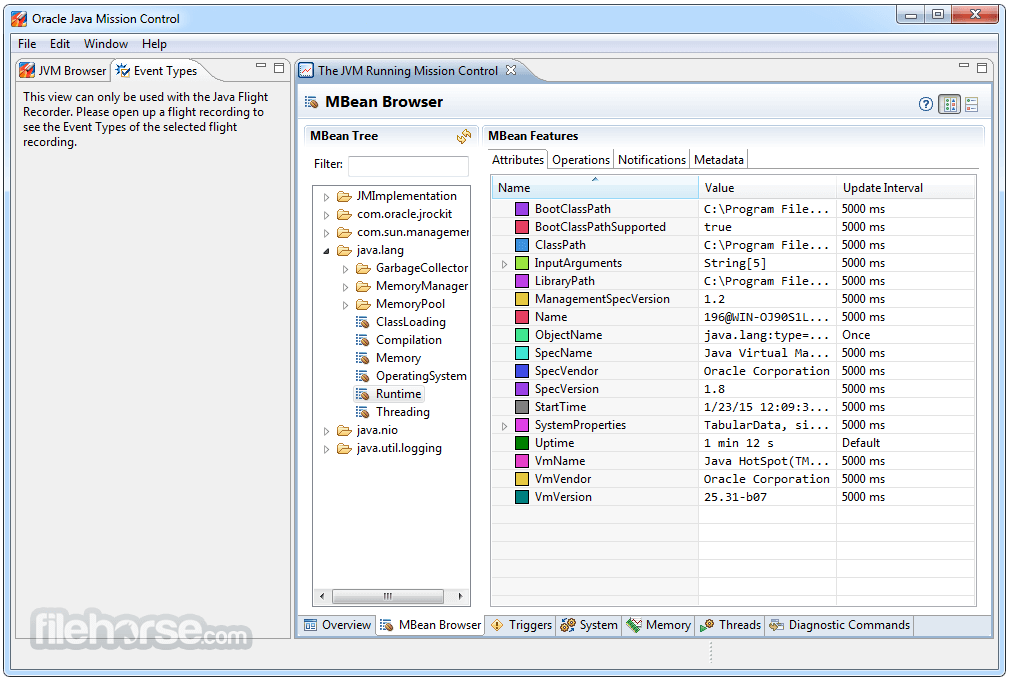Sep 21, 2021 Download the latest version of Java SE Development Kit 16 for Mac for free. Compare with similar apps on MacUpdate.
Freeware download - Java SE Development Kit (JDK) for Mac OS X 12.0.2 freeware download - The basic resources you need in order to create apps in Java - Freeware downloads - best freeware - Best Freeware Download. Java Development Kit for Mac Java Development Kit for Mac (also known as JDK) is a highly professional cross-platform SDK platform created and regularly supported by Oracle Corporation.With a goal of providing specific implementation of Java SE, Java EE and Java ME platforms developers from all around the world use it. What is Java SE Development Kit 7 for Mac. The Java SE Development Kit 7 lets you develop and deploy Java applications on desktops and servers, as well as in today's demanding embedded environments. Java offers the rich user interface, performance, versatility, portability, and security that today’s applications require. Homebrew install latest Java on macOS. 1.1 Install and upgrade Homebrew. 1.2 brew search java to find all available Java-related formula.% brew search java Formulae app-engine-java java javacc jslint4java pdftk-java google-java-format java11 javarepl libreadline-java. 1.3 brew info to show the formula details.
Are you new to SciChart? Check out our most popular pages to get started below:
The following guide will help you setup a Development Environment for Android on Mac OS. You can skip this if you already have Android Studio and the Android NDK setup!
1. Using safari, navigate to https://www.java.com/en/download/ and download Java 8 for mac.
2. You will also need to install the Java Platform JDK from http://www.oracle.com/technetwork/java/javase/downloads/index.html
NOTE: Make a note of your JDK Install path. For instance, /Library/Java/JavaVirtualMachines/jdk1.8.0_45.jdk/Contents/Home. This will be required later when setting environment variables
Download Android Studio for MAC from the https://developer.android.com/studio/index.html#downloads. Follow the steps to install the application in OSX.
You can start the application from the Applications folder, or from Spotlight, by searching CMD+SPACE and typing ‘Android Studio’
On first start, Android Studio will try to download the Android SDK. This may take a while. Make a note of where the Android SDK was installed to, this is very useful for certain operations in Android!
Once that’s done, open Android Studio and go to Tools -> Android -> SDK Manager. Under SDK Platforms ensure you have selected the platform(s) you want to develop for. For instance, we require v4.4 – v6 for SciChart Android development.
Next, under SDK Tools ensure ‘Android SDK Build Tools’ is up to date. Also download the Android NDK v12.
Click OK to install all components.
Certain components in SciChart Android are dependent on the Android NDK (Native Development Kit). Installing this is required if you are building our examples or SciChart Android library from source-code.
The Android NDK can be downloaded via the SDK Manager within Android Studio. Go to Tools -> Android -> SDK Manager. Under Build tools ensure the Android NDK is checked and up to date.
Gradle is the command-line build tool for Java and Android applications. SciChart uses Gradle to build libraries (AARs, which contain JAR and resource files) which can be used in your own applications.
If you are compiling SciChart Android from our source code, it is recommended you install Gradle. Following the instructions from StackOverflow at http://stackoverflow.com/a/28928107/303612
- Install Homebrew (a package manager for OSX)
/usr/bin/ruby -e '$(curl -fsSL https://raw.githubusercontent.com/Homebrew/install/master/install)' - Install Gradle
brew install gradle
Setting Mac OSX Environment Variables

The following environment variables must be set to allow development of SciChart Android in Android Studio on OSX.
- JAVA_HOME: The location of the Java JDK
- ANDROID_HOME: The location of the Android SDK on disk
- ANDROID_NDK_HOME: The location of the Android NDK on disk
To set environment variables so that they may be read by OSX Applications, you will need to follow these steps.
- Press CMD+Space to open Spotlight and search for Apple Script Editor.
- Open Apple Script Editor
- Type into Apple Script the following commands to set environment variables:
do shell script 'launchctl setenv JAVA_HOME /Library/Java/JavaVirtualMachines/jdk1.8.0_45.jdk/Contents/Home'
do shell script 'launchctl setenv ANDROID_HOME /users/$(whoami)/Library/Android/sdk'
do shell script 'launchctl setenv ANDROID_NDK_HOME /users/$(whoami)/Library/Android/sdk/ndk-bundle'
4. Save the file with FileFormatApplication in your Documents/ folder and name it EnvironmentVars.
5. Next, in Spotlight, search for System Preferences -> open Users and Groups.
6. Under your username, click Login Items.
7. Add the EnvironmentVars script to the login items, so that this script is opened every time you login.

8. Finally, log out and log back in to your mac.
9. After logging in, wait a moment for the script to run (it can take 10 seconds after startup). Then, you can verify that all environment variables have been set correctly by opening a new Terminal window and typing
a. echo “$ANDROID_HOME”
b. echo “$ANDROID_NDK_HOME”
c. echo “$JAVA_HOME”
These should resolve to the correct directories where the Android SDK, NDK and JDK are installed respectively.
The latest version of Reading App Builder can be downloaded here. Please see the Release Notes for details of what’s new in this version.
DOWNLOAD CURRENT VERSIONReading App Builder 9.0.1 for Windows
EXE | 315.14 MB | 19 Aug 2021
Windows Version
| Reading App Builder 9.0.1 | for Windows |
This is the download for building Android apps on a computer running Windows. Follow the installation instructions in the document 1. Installation Instructions.
Recommended system:
- a laptop or desktop PC running Windows 7, 8 or 10 (64-bit);
- 4 GB of free hard disk space;
- 4 GB of RAM;
- an Android smartphone;
- a USB cable to connect the smartphone to the computer;
- an internet connection (required only for the build of the first app).
Mac Version
| Reading App Builder 9.0.1 | for Mac |
This is the download for building Android and iOS apps on a Mac. Follow the installation instructions in the document 3. Installing and Building Apps on a Mac.
Recommended system:
- a Mac running macOS 10.13 (minimum);
- 12GB (minimum), 20GB or more (recommended) of free hard disk space for Xcode install;
- 4GB of RAM (minimum), 8GB of RAM (recommended);
- For building iOS apps:
- iPhone, iPod Touch or iPad running iOS 10.0 or greater;
- Lightning cable to connect iOS device to Mac;
- For building Android apps:
- an Android smartphone;
- a USB cable to connect the smartphone to the computer;
- an internet connection (required only for the build of the first app).
Download Oracle's Java Development Kit (jdk) On Mac Os X 10.10
For details of which features are supported in the iOS app, please see Android and iOS App Features.
Linux Version
For instructions on how to download and install Reading App Builder for Linux, please see section 3 in the Installation Instructions document on the Resources page.
Documentation
Please see the Resources page for documentation to download.
Jdk 1.8 Download
Audio Synchronization Tools
You can download the installer for the aeneas audio-text synchronization tools here. Choose the download according to your operating system (Windows or Mac). For Linux, the aeneas install is part of the Reading App Builder package and you do not need to install it separately.
| aeneas tools 1.7.3 | for Mac |
| aeneas tools 1.7.2 | for Mac |
| aeneas tools 1.7.3 | for Windows |
| aeneas tools 1.7.2 | for Windows |
If you have previously installed each of the aeneas components using the manual method, we recommend that you uninstall each of these before installing the new version. The new installer installs the components to different places and in a different way from the manual method.
Necessary Development Kits
In addition to the Reading App Builder (RAB) installation file you will need to download and install the Java and Android development kits. These are used by Reading App Builder to compile Android apps. The Installation Instructions include step by step help for installing these development kits. If this is your first time installing RAB it is strongly recommended that you follow those instructions which include screenshots so you know exactly what to download.
Java Development Kit – You need version 8 of the Java Development Kit (JDK). We recommend that you use Azul Zulu OpenJDK which is a free distribution of the Open Java Development Kit.
Android Software Development Kit – Use the Install Android SDK wizard within Scripture App Builder to download and install the Android SDK.
Previous Versions
Jdk 1.8 For Mac
Older versions of Reading App Builder can be downloaded here.| Reading App Builder 9.0 | for Mac |
| Reading App Builder 8.6.6 | for Mac |
| Reading App Builder 8.6.5 | for Mac |
| Reading App Builder 8.6.3 | for Mac |
| Reading App Builder 8.6 | for Mac |
| Reading App Builder 8.5 | for Mac |
| Reading App Builder 8.4 | for Mac |
| Reading App Builder 8.3.1 | for Mac |
| Reading App Builder 8.3 | for Mac |
| Reading App Builder 8.2 | for Mac |
| Reading App Builder 8.1 | for Mac |
| Reading App Builder 8.0.1 | for Mac |
| Reading App Builder 8.0 | for Mac |
| Reading App Builder 7.2 | for Mac |
| Reading App Builder 7.1 | for Mac |
| Reading App Builder 7.0.2 | for Mac |
| Reading App Builder 6.2.2 | for Mac |
| Reading App Builder 6.1 | for Mac |
| Reading App Builder 9.0 | for Windows |
| Reading App Builder 8.6.6 | for Windows |
| Reading App Builder 8.6.5 | for Windows |
| Reading App Builder 8.6.3 | for Windows |
| Reading App Builder 8.6.2 | for Windows |
| Reading App Builder 8.6.1 | for Windows |
| Reading App Builder 8.6 | for Windows |
| Reading App Builder 8.5 | for Windows |
| Reading App Builder 8.4 | for Windows |
| Reading App Builder 8.3.1 | for Windows |
| Reading App Builder 8.3 | for Windows |
| Reading App Builder 8.2 | for Windows |
| Reading App Builder 8.1 | for Windows |
| Reading App Builder 8.0.1 | for Windows |
| Reading App Builder 8.0 | for Windows |
| Reading App Builder 7.2 | for Windows |
| Reading App Builder 7.1 | for Windows |
| Reading App Builder 7.0.2 | for Windows |
| Reading App Builder 6.2.2 | for Windows |
| Reading App Builder 6.1 | for Windows |